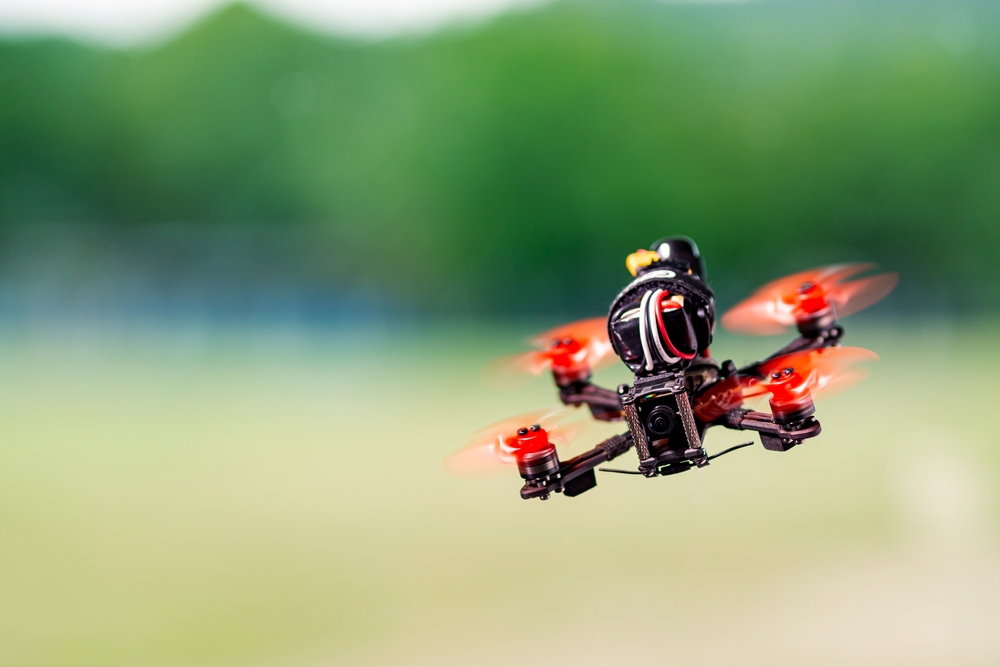Competitive Drone Racing: Pushing the Boundaries of Virtual and Physical Skills
The world of competitive drone racing has emerged as a thrilling fusion of cutting-edge technology and human skill, captivating audiences and participants alike. This high-octane sport combines the precision of remote-controlled flight with the adrenaline rush of high-speed racing, creating a unique spectacle that challenges both pilots and engineers. As drones zip through elaborate courses at breakneck speeds, competitors must navigate complex obstacles, execute hair-raising maneuvers, and make split-second decisions, all while viewing the world through their drone's onboard camera.

As the sport gained popularity, leagues and organizations began to form, establishing standardized rules and regulations. The Drone Racing League (DRL), founded in 2015, played a pivotal role in bringing the sport to mainstream audiences. By broadcasting races on major sports networks and partnering with established brands, the DRL helped legitimize drone racing as a competitive sport and paved the way for its global expansion.
The Technology Behind the Thrill
At the heart of competitive drone racing lies a sophisticated blend of aerodynamics, electronics, and software engineering. Racing drones, unlike their consumer counterparts, are custom-built for speed and agility. These machines typically feature a lightweight carbon fiber frame, high-power motors, and specialized propellers designed to maximize thrust while minimizing drag.
The FPV system, a crucial component of racing drones, consists of a small camera mounted on the drone’s front, which transmits live video feed to the pilot’s goggles. This setup allows racers to navigate courses as if they were sitting in a miniature cockpit, providing an immersive and thrilling experience. Advanced flight controllers and GPS systems help stabilize the drone and provide precise control, enabling pilots to execute complex maneuvers with remarkable accuracy.
Recent technological advancements have pushed the boundaries of what’s possible in drone racing. Some competitions now feature autonomous racing categories, where drones navigate courses using artificial intelligence and computer vision systems. This intersection of human skill and machine learning presents exciting possibilities for the future of the sport.
The Pilot’s Perspective: Skills and Training
Becoming a competitive drone racer requires a unique set of skills that blend physical dexterity with mental acuity. Pilots must develop lightning-fast reflexes, spatial awareness, and the ability to process visual information at high speeds. The sport demands intense concentration and the capacity to make split-second decisions while operating in a three-dimensional space.
Training for drone racing often begins with simulator programs that allow pilots to practice in virtual environments. These simulators mimic real-world physics and race conditions, providing a safe and cost-effective way for beginners to hone their skills. As pilots progress, they transition to flying actual drones, starting with slower speeds and simpler courses before advancing to more challenging scenarios.
Many professional drone racers come from backgrounds in traditional motorsports, aviation, or esports. This diverse pool of talent contributes to the sport’s dynamic nature, with different pilots bringing unique flying styles and strategies to the competition. Some excel at high-speed straightaways, while others shine in technical sections that require precise maneuvering.
The Racing Experience: Courses and Competitions
Drone racing courses are designed to test pilots’ skills across various challenges. Typical race formats include time trials, head-to-head elimination rounds, and multi-drone races. Courses often feature a mix of gates, obstacles, and sharp turns, requiring pilots to navigate complex three-dimensional paths at speeds exceeding 80 miles per hour.
Indoor races take place in arenas or repurposed spaces, allowing for controlled lighting and precise course design. These events often incorporate elaborate LED-lit gates and obstacles, creating a visually stunning spectacle for both pilots and spectators. Outdoor races, on the other hand, introduce additional challenges such as wind, varying light conditions, and natural obstacles.
Major drone racing competitions attract pilots from around the world, offering substantial prize pools and sponsorship opportunities. The DRL’s World Championship, for example, features a series of races culminating in a final event with a prize of $100,000 for the winner. Other notable competitions include the MultiGP Drone Racing Championship and the FAI Drone Racing World Cup.
The Impact on Aviation and Beyond
The rise of competitive drone racing has had far-reaching implications beyond the sport itself. The technical innovations driven by the need for faster, more agile racing drones have spilled over into other areas of aviation and robotics. Advances in battery technology, lightweight materials, and control systems developed for racing drones are now being applied to commercial and industrial drone applications.
Moreover, the sport has inspired a new generation of engineers and pilots, fostering interest in STEM fields among young enthusiasts. Many schools and universities now offer drone racing clubs and competitions, recognizing the educational value of the sport in teaching principles of physics, aerodynamics, and electronics.
The drone racing community has also been at the forefront of advocating for responsible drone use and safety regulations. As the sport has grown, organizations have worked closely with aviation authorities to develop guidelines that ensure the safety of pilots, spectators, and the general public while allowing the sport to flourish.
The Future of Drone Racing: Innovations and Challenges
As drone racing continues to evolve, several trends are shaping its future. One exciting development is the integration of augmented reality (AR) into races. AR technology could allow spectators to view real-time data overlays, such as drone speeds and race positions, enhancing the viewing experience. Some experts envision a future where virtual and physical elements are seamlessly blended, creating hybrid courses that combine real-world obstacles with digital challenges.
The ongoing miniaturization of drone components is another area of innovation. As drones become smaller and more powerful, races could potentially be held in even more diverse and challenging environments. Some enthusiasts speculate about the possibility of indoor micro-drone races that could take place in office buildings or even households, bringing the sport to new venues and audiences.
However, the sport also faces challenges as it grows. One primary concern is maintaining a balance between technological advancement and pilot skill. As drones become more sophisticated, there’s a risk that the human element could be overshadowed by automated systems. Leagues and organizations are working to establish rules that preserve the essence of the sport while embracing innovation.
Another challenge lies in making the sport more accessible to newcomers. The cost of high-end racing drones and equipment can be prohibitive for many potential pilots. Efforts are underway to develop more affordable entry-level gear and to create grassroots leagues that cater to beginners and hobbyists.
The Cultural Impact of Drone Racing
Drone racing has begun to carve out its own unique subculture, blending elements of traditional motorsports with the tech-savvy world of esports. This fusion has attracted a diverse community of enthusiasts, from adrenaline junkies to tech geeks, creating a vibrant ecosystem of pilots, builders, and fans.
The sport’s aesthetic, characterized by neon lights, futuristic designs, and high-tech gear, has influenced fashion and art within the community. Custom-designed pilot suits, decorated drones, and elaborate race venues all contribute to the sport’s distinctive visual identity. This unique culture has started to permeate mainstream media, with drone racing featured in movies, TV shows, and video games.
Social media and online platforms have played a crucial role in the growth of drone racing culture. Pilots share flight footage, building tips, and race strategies on platforms like YouTube and Instagram, fostering a global community of enthusiasts. These online spaces have become invaluable resources for newcomers and experienced pilots alike, accelerating the sport’s development and spreading its appeal worldwide.
The Economic Ecosystem of Drone Racing
As drone racing has grown from a niche hobby to a professional sport, it has spawned a robust economic ecosystem. Manufacturers of racing drones and components have seen significant growth, with companies specializing in everything from frames and motors to flight controllers and FPV systems. This has led to rapid innovation cycles, with new products and technologies constantly entering the market.
The sport has also attracted investment from major tech companies and venture capital firms, recognizing the potential for growth and technological spillover. Sponsorships from brands looking to associate themselves with the high-tech, high-adrenaline world of drone racing have become a significant source of funding for leagues and individual pilots.
Broadcasting rights for major drone racing events have become increasingly valuable, with networks recognizing the sport’s appeal to younger, tech-savvy audiences. This has led to improvements in production quality and race coverage, making the sport more accessible and engaging for viewers.
Environmental Considerations in Drone Racing
As the sport of drone racing continues to grow, there’s an increasing focus on its environmental impact. While racing drones are electric and don’t produce direct emissions, concerns have been raised about the environmental footprint of manufacturing and disposing of drone components, particularly batteries.
In response, some leagues and manufacturers are exploring more sustainable practices. This includes developing more durable components to reduce waste, implementing recycling programs for used drones and batteries, and researching biodegradable materials for drone construction. Some competitions have even introduced categories for eco-friendly drones, encouraging innovation in sustainable design.
The drone racing community is also leveraging its platform to raise awareness about environmental issues. Races have been organized in conjunction with conservation efforts, using drone footage to showcase natural habitats and highlight the importance of preserving ecosystems.
The Intersection of Drone Racing and Urban Planning
The unique requirements of drone racing courses have begun to influence urban planning and architecture. As the sport gains popularity, some cities are considering dedicated drone racing facilities as part of their recreational infrastructure. These purpose-built venues could serve as multi-functional spaces, hosting races while also providing facilities for drone education and testing.
Abandoned industrial sites and underutilized urban spaces are being repurposed as drone racing venues, breathing new life into these areas. This trend aligns with broader urban renewal efforts, creating community spaces that blend technology, sport, and entertainment.
Some forward-thinking architects are even incorporating drone-friendly features into building designs, envisioning a future where urban environments could host impromptu races or serve as training grounds for pilots. These concepts challenge traditional notions of how we interact with urban spaces and highlight the potential for technology to reshape our cities.
The Psychological Aspects of Drone Racing
The mental demands of drone racing have attracted the attention of sports psychologists and cognitive scientists. Pilots must maintain intense focus while processing complex visual information and making rapid decisions, all while managing the physical and emotional stress of competition.
Studies have begun to explore the cognitive benefits of drone racing, with some researchers suggesting that the sport could improve spatial awareness, hand-eye coordination, and decision-making skills. These findings have implications beyond the sport itself, potentially informing training methods for other high-stress, rapid-response professions such as emergency services or military operations.
The immersive nature of FPV flying has also led to investigations into its effects on perception and consciousness. Some pilots report experiences akin to flow states or out-of-body sensations, raising intriguing questions about the nature of embodiment and spatial cognition in virtual environments.
Drone Racing as a Platform for STEM Education
Educational institutions are increasingly recognizing drone racing as a powerful tool for engaging students in STEM subjects. The multidisciplinary nature of the sport, encompassing physics, engineering, computer science, and mathematics, provides a practical, hands-on approach to learning complex concepts.
Schools and universities are incorporating drone racing into their curricula, using it as a framework to teach everything from basic aerodynamics to advanced programming. Student drone racing leagues have emerged, fostering teamwork, problem-solving skills, and healthy competition.
These educational initiatives are not limited to traditional academic settings. Community programs and after-school clubs focused on drone racing are providing accessible entry points into STEM fields for underrepresented groups, helping to diversify the pipeline of future engineers and technologists.
The Global Expansion of Drone Racing
While drone racing originated in Western countries, it has rapidly spread to become a truly global sport. Competitions are now held in countries across Asia, Africa, and South America, each region bringing its own cultural flavors and flying styles to the sport.
This global expansion has led to interesting cross-pollinations of ideas and techniques. Pilots from different backgrounds bring unique perspectives to drone design and racing strategies, contributing to the sport’s continuous evolution. International competitions serve as melting pots for these diverse approaches, driving innovation and pushing the boundaries of what’s possible in drone racing.
The sport’s growth in developing countries is particularly noteworthy. In some regions, drone racing is seen as a potential economic driver, offering opportunities for technological development and job creation in the emerging drone industry.
Ethical Considerations in Competitive Drone Racing
As drone racing continues to grow, it faces ethical challenges that require careful consideration. One primary concern is privacy, as the high-quality cameras used in racing drones could potentially be misused for surveillance. Leagues and pilots are working to establish strict guidelines to ensure that racing activities respect privacy rights and adhere to local regulations.
Another ethical dimension relates to the potential dual-use nature of racing drone technology. The skills and technologies developed for sport could have applications in military or law enforcement contexts, raising questions about the responsibility of the racing community in preventing misuse.
The sport is also grappling with issues of inclusivity and diversity. While drone racing has the potential to be more accessible than traditional motorsports, barriers to entry still exist. Efforts are being made to create more pathways for underrepresented groups to enter the sport, both as pilots and in supporting roles.
Conclusion: The Ascent of a Futuristic Sport
Competitive drone racing stands at the forefront of a new era in sports, where the physical and digital worlds converge. Its rapid evolution from underground hobby to professional sport reflects broader technological and cultural shifts, offering a glimpse into the future of human-machine interaction and competition.
As the sport continues to mature, it faces the challenge of balancing technological innovation with the core elements that make it thrilling and accessible. The coming years will likely see further advancements in drone technology, more immersive viewing experiences, and an expanding global footprint for the sport.
Beyond the races themselves, drone racing’s impact resonates through various sectors, from education and urban planning to environmental conservation and cognitive science. It serves as a catalyst for innovation, a platform for STEM education, and a bridge between diverse communities worldwide.
The journey of competitive drone racing is far from over. As it soars into the future, it carries with it the potential to reshape our understanding of sport, technology, and human skill in the 21st century. Whether viewed as a high-tech spectacle or a serious athletic pursuit, drone racing has undoubtedly secured its place in the pantheon of modern sports, promising an exciting and unpredictable flight path ahead.





